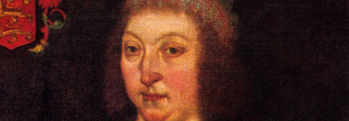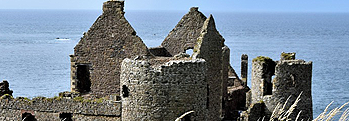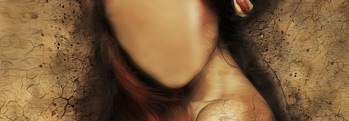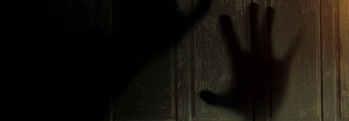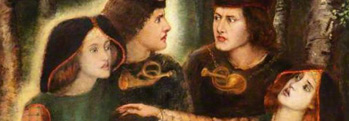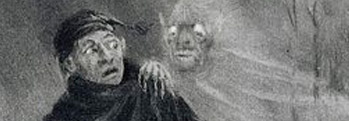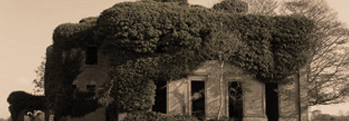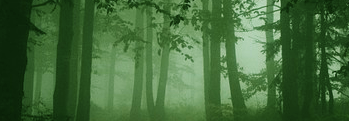The Hellfire Club
Irish and Celtic myths and legends, Irish folklore and Irish fairy tales and Irish Ghost Stories
English gentry and their bad habits at The Hellfire Club
High on a windswept slope in the Wicklow mountains near the summit of Mount Pelier, with a commanding view overlooking Dublin city, lies the burnt and blackened shell of a sinister old hunting lodge, now called the Hellfire Club, and well named it was too! For it was home to the Irish branch of that selfsame society, notorious for drunken debauchery and conducting unholy rites at the darkest hour of the night.
It was first constructed by the Right Honourable William Conolly of Castletown, who was a Speaker in the Irish parliament in 1725. An enormously wealthy man, he is said to have destroyed an ancient cairn, a tomb of the old people, in order to clear the way for his hunting lodge. So when the roof of that lodge was pulled clean off shortly after in a mighty storm, the local people knew what to think!
Not a man to be dissuaded by what he felt to be local superstition, Conolly rebuilt the house with a strong arch roof of solid stonework and contented himself that he had beaten the devil of the mountains, but it became known as a place of ill repute thereafter.
 Six years after his death the lodge was purchased by Richard Parsons, the first Earl of Rosse, freemason master and president of the Hellfire Club, a group who delighted in fashionable blasphemy and carousing, attracting the membership of young Bucks as they were known, a sort whose whole enjoyment and the business of whose life seemed to consist of eccentricity and violence. The president of the club was known as "The King of Hell" and dressed himself as Satan, with horns and cloven hoofs, and in the devil's name was the first toast always drunk and a chair left unoccupied for Old Hob.
Six years after his death the lodge was purchased by Richard Parsons, the first Earl of Rosse, freemason master and president of the Hellfire Club, a group who delighted in fashionable blasphemy and carousing, attracting the membership of young Bucks as they were known, a sort whose whole enjoyment and the business of whose life seemed to consist of eccentricity and violence. The president of the club was known as "The King of Hell" and dressed himself as Satan, with horns and cloven hoofs, and in the devil's name was the first toast always drunk and a chair left unoccupied for Old Hob.
Their shameless festivities knew no bounds, admitting men and women in equal measure to partake of black masses, so called "Holy Ghost Pie" and drinking scaltheen, a noxious mixture of whiskey and butter. Their decadence didn't blush at holding orgies and animal sacrifices, worshipping pagan deities and going on wild rides through the surrounding countryside, beating local villagers and taking whatever they wanted. More than once, it was said, strange visitors in peculiar attire would arrive in the midst of their feasting and dance wildly before vanishing in a flare of sulphur.
Not so long ago the skeleton of a dwarf and a demonic statue were unearthed under a house at the foot of the hill. They even went so far as to kidnap a local woman and roll her down the hill in a barrel after setting it alight, not a one of them being convicted of the murder afterwards, for such was the nature of the times and the secrecy of the club.
So it was no surprise that unpleasant legends and tales grew up like wild weeds about the old hunting lodge and its new occupants. A young man was visiting a local farmhouse when he heard of this notorious club, and decided to pay it a visit to see what was what. The very next day he was found murdered and face down in a shallow pool. His host, appalled, determined that he'd beard the lion in its den and brought with him a priest for good measure.
Well the sun had set by the time they made it to the doors, which were answered by a tall man in dark clothing. They were seized and forced to sit at a sumptuous feast that was about to begin. At that, a huge black cat stalked into the room, which had not ears but horns like a goat. Upon seeing the beast and the malevolent glare it laid upon him, the priest leapt to his feet, knowing he was done for if he didn't move quickly.
Again he was grabbed but he reached into his pocket for a vial of holy water he kept there, and hurling it at the cat he uttered the words of the exorcism. With that all hell broke loose, fire and smoke erupted, and he escaped out the front door with the piteous cries of his farmer friend echoing in his ears!
The next morning the farmer was found scratched and cut about the head and face and he never spoke a word from that day forth. Some say the Hellfire Club ended on that day, while others tell how its master's misadventure finally closed the doors. That was one Richard Chappell "Burn-Chapel" Whaley, another of the decadent ascendancy who'd gotten his name by riding around and setting fire to the thatch of Catholic chapels.
After a black mass it is said a footman stumbled over the slumped figures of insensate orgiasts, spilling whiskey on Whaley's coat. Infuriated, Whaley poured brandy on the man, setting him alight, and soon the whole place was ablaze, revellers and all.
However it ended, local people shun the hilltop now, disliking to tempt the wrath of the many dark spirits said to haunt its windswept trails yet, and no animal will set foot on it. Should you venture that far, you may hear the shrieks of tortured women echoing from a distance, or odd smells as of brimstone and soot, or you may feel a hand pushing you or pressure on our chest or head.
And if you hear the hiss of a cat, it may be time to beat a hasty retreat!
The shell of the old Hellfire Club is marked on the map below, and its story is not yet done, for a team of archaeologists were digging in the vicinity and found partial ruins from an ancient megalithic tomb early in 2021! Lead archaeologist Neil Jackman was stunned by the series of coincidences that lined up to allow his team to spot something that had been lost to time and memory.
"If we placed the trench a metre to the left or right and we wouldn’t have found it. If we excavated during the summer the high flat light would never have shown it up. If we had taken the stone straight to the spoil heap we wouldn’t have seen it. If we hadn’t have accidentally placed the stone with the art facing at a perfect oblique angle to the sun’s position in the morning it would have never been noticed.
Although it is pretty corny to say so, it’s almost like some things just want to be found."
More Irish Ghost Stories
There once was a woman called Máire Rua, or Red Mary, since she was one of the McMahons and had hair like a fiery sunset with a temper to match! Many legends have grown up around this seventeenth century force of nature, some true, some maybe less so, and some she spread herself! She made her seat in Leamanagh Castle, in the Burren in Cou ... [more]
If Dublin is the capital city of Ireland, County Clare is its dark reflection on the other side of the country, a place where many of the shadowy tales and unsolved mysteries of bygone years eventually seem to flow. Layer upon layer of centuries burden its rocky hills, left behind by the passage of numberless and nameless peoples, each hiding their ... [more]
Little remains now of once-proud Dunluce castle, whose halls had echoed with the sounds of laughter and music, and whose vaulted arches had defied the most ferocious storms. Only echoes and shadows are left behind, and some say, the tormented ghost of a young lady waiting for her love to return! The castle had originally been built by Richard &O ... [more]
The tale of Kilmagoura in County Cork is, for the most part, a peaceful and quiet one, as it lay under the power of the Fitzgeralds for many years, and they were, for the most part, just and fair rulers. So good were they that nobody had anything bad to say about them, and tales were told of their heroism and generosity. But as they say, it is t ... [more]
The long shadow of Leap Castle in County Offaly stretches across many centuries, and from its dark depths echo tales of terror, murder and the dread hand of the supernatural reaching from beyond the grave! The land upon which the O'Bannon clan built Leap Castle in the thirteenth century was not unoccupied – in fact, it had been used by ... [more]
Once upon a time in Tyrone there were two little children, the son and daughter of parents who had died when they were little. They missed their parents very much, but they were raised by a guardian who was a fanatical atheist, and was determined to convert the children to his beliefs. But they would have none of it, and so they made a childhood ... [more]
Every year around Halloween, people carve pumpkins or turnips into faces and put candles inside them, but not many know that this custom came from Ireland originally, or the story behind it! They say there was a blacksmith many years gone who was fond of his drink, and a mean drunk he was too, and tight with it. Not many friends did stingy Jack ... [more]
There was a famous beauty who lived in Belvelly castle overlooking Cork Harbour in the seventeenth century, and word of her ethereal comeliness spread far and wide. It reached the ears of a local lord by the name of Clon Rockenby, and he declared he must have her for his wife. Her name was Lady Margaret Hodnett, and although she was quite fond o ... [more]
The Redmonds were a comfortably well off family living in Court street in Enniscorthy back in 1910, and they supplemented their income by renting out rooms in their house to lodgers. However, their quiet life was soon to be interrupted by a sinister guest they hadn't invited in! In July of that year they had rented out the room above the kit ... [more]
It was the year 1280 in Kyteler's House in Kilkenny that Dame Alice Kyteler was born to a family of good prospects, a family of Flemish merchants who had settled in Kilkenny. When she grew up, Alice married William Outlawe, a wealthy merchant and moneylender, by whom she had a son. Then she married to her second husband, Adam le Blund of Callan ... [more]
One of the oldest legends in Ireland is that of the Fetch, the ghost of the living, which some say comes down from the ancient Irish word for seer or prophet, fáith. It is a double-spirit, one which takes on the identical appearance of someone as an omen of their impending death, if seen in the evening, or as a promise of good fortune if see ... [more]
They do say Irish people are fond of a good chat, the gift of the gab as it's called, but it seems even Irish ghosts are likewise inclined, as the strange tale of Corney the phantom reveals! Many years ago in Dublin city, a young family moved into a fine residence in the heart of Dublin city. Well-to-do and respectable, they made their new h ... [more]
In the south of the country, from Cork to Waterford, parents often scold wilful children with the warning – behave or Petticoat Loose will get you! And a wise child will do as they are told, for there are few more chilling tales than those of Petticoat Loose. Patrick Flynn's wife was in her labour pains near Ballingeary on a cold night ... [more]
High on a windswept slope in the Wicklow mountains near the summit of Mount Pelier, with a commanding view overlooking Dublin city, lies the burnt and blackened shell of a sinister old hunting lodge, now called the Hellfire Club, and well named it was too! For it was home to the Irish branch of that selfsame society, notorious for drunken debaucher ... [more]
William Phibbs was a well-to-do landlord of the English nobility who decided to develop his considerable estates in Ireland, building a house for himself overlooking the beautiful Ballisodare Bay in Sligo back in 1798. It would be a fine place to enjoy the sunset over Atlantic waters, he decided, and his son used it so. His grandson, also named Wil ... [more]
The old house in Coonen is much spoken of even today, its dark legend stretching back into the mists of time. Some say it is a ghost living there, others say a devil, but rumours go back further into the darkness of elder years, to the old gods of Ireland and the dark rites that were celebrated in their name. The house in Cooneen first entered t ... [more]
The headless horseman is a very ancient tale of Ireland, stretching back to the days before Christ came with St Patrick, when a dark king used to sacrifice people to old black one-eye, Crom Cruach, by decapitation. That very same Crom Dubh, the worm god, who consumed the Druid Prince Cesard in green bubbling acid at the battle of Moy Tura after his ... [more]




